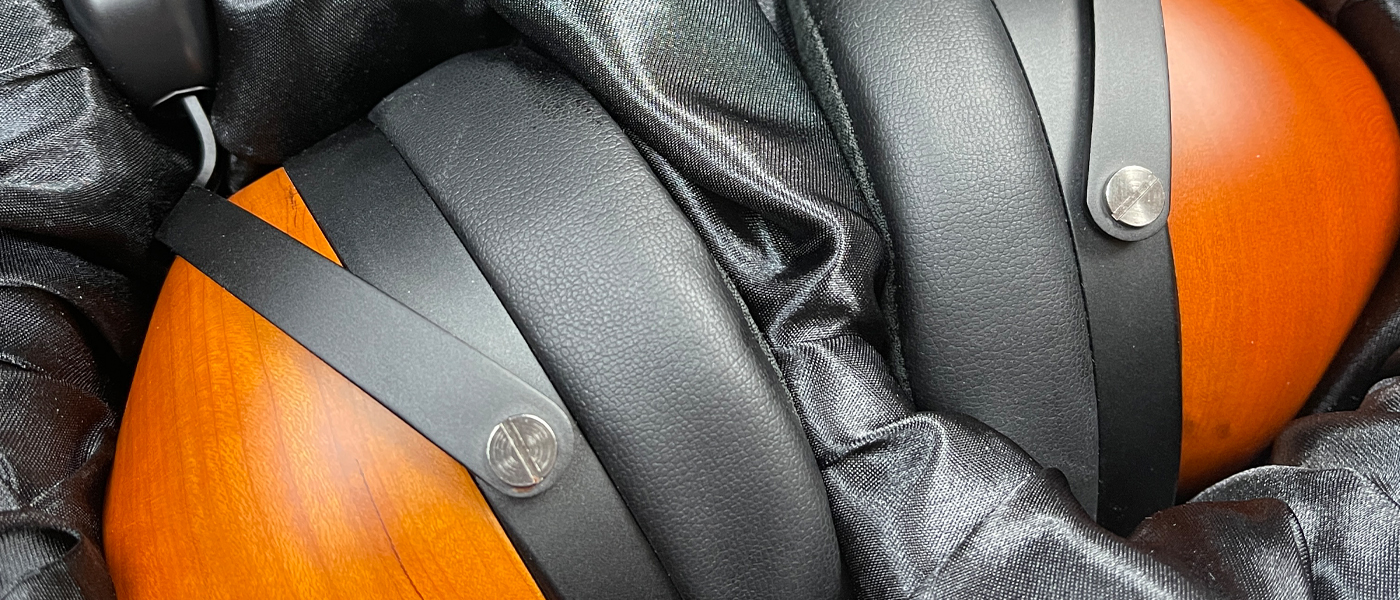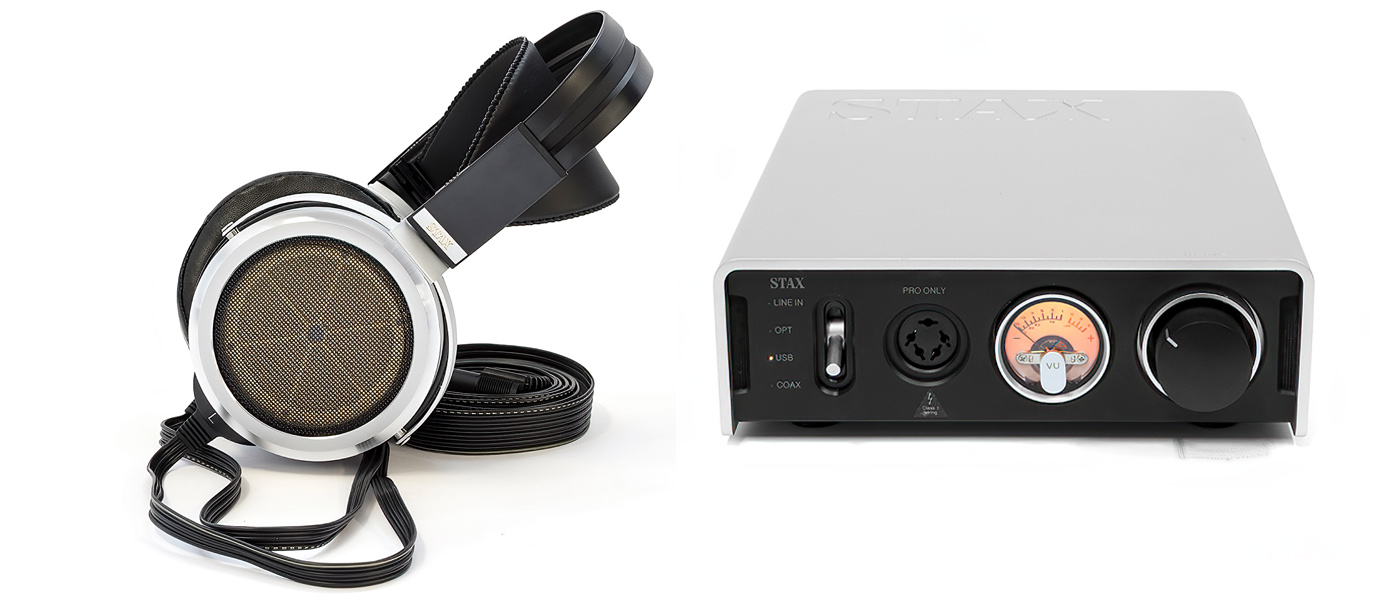
Everyone in the headphone business has a different approach to voicing their headphones, how to construct them, deciding what the best fit and finish is, and even trying to find the most effective cables to use. Even with so many headphones reviewed, I jumped at the chance to listen to the Stax SR-009S Electrostatic headphones, or “Earspeakers” in Stax-speak. Stax calls these their flagship product, so I was interested how their proclaimed best of the best sounded, and what you got for your $4545.00 investment. I had hopes it would calibrate my listening for other headphones I own, and others I would have the chance to listen to.
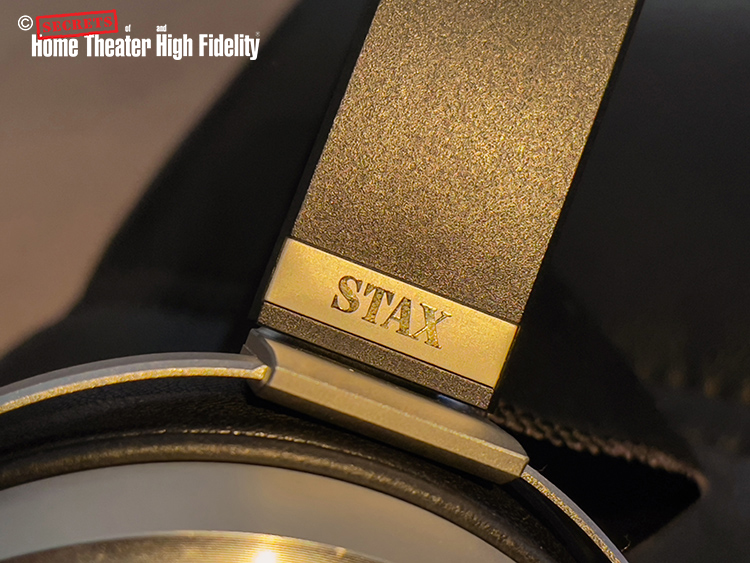
As followers of Stax will know, these headphones don’t just plug in to any headphone jack. Because they require high voltage to generate audio, they need a special amplifier, and Stax was nice enough to send one along. It’s the SRM-D50, which adds $1260 to your bill. The SRM-D50 is a high-performance electrostatic driver and Digital-to-Analog Converter. With a striking all-in-one design, it supports various digital inputs such as USB, optical, and coaxial digital input and has a built-in DAC that can handle high resolution files up to PCM 32/384 kHz or DSD 5.6.
So how did these two esoteric components sound? In a couple of words, beyond expectations. I fed these Stax devices the best high-resolution files I had on hand. I listened to Tidal streaming, CDs, SACDs, analog reel-to-reel tape, and some lowly MP3 files I keep around on a backup hard disc. The better the files, the better the sound. The MP3s sounded generally dreadful, as the Stax headphones were revealing of the noise, the glare, and the ragged and often non-existent high end. Reel-to-reel tapes sounded pretty good, but the tape hiss just made the format difficult to listen to. CDs and SACDs were very listenable, and I was hearing details that had eluded me. Overall, as with electrostatics in general, the high frequencies were wonderful. The midrange was solid, and the bass was surprisingly deep and revealing. Bass is an area where electrostatic deigns are not always at their best. But with these top-of-the-line Stax, bass was deep and natural. In a word, these headphones were neutral, in contrast to many other headphones that pick an area of the frequency spectrum and emphasize it.
When I give you these highlights, and generally in the review, I’m referring to the headphones and the accompanying amp/DAC as a system, taken together as one.
Stax SR-009S Signature Electrostatic and SRM-D50 Driver and DAC
- The SR-009S headphones were comfortable and the included long cord made them easy to use.
- The built quality is excellent for the phones, headband, and cable connections. Nothing is flimsy, or likely to fail over time.
- The sound could not be faulted.
- The SRM-D50 Amplifier has a VU meter. I love VU meters. And it’s illuminated! I’m not sure it’s needed, but it makes the D50 look great.
- Even with a long cord, you’re going to have to sit close to your source components.
The first electrostatic headphone can be traced back to – you guessed it, Stax, who introduced the Stax SR-1, back in 1960. A few others followed, most notably Koss, which offered a self-powered model that did not need an amplifier. The Koss models had a good following, but Stax was considered the leader back then and is still the leader now.
The way electrostatic headphones work is unique. A high voltage is applied to two thin electrodes. Like the way a loudspeaker works, this voltage causes a foil diaphragm to vibrate with the audio signal. The result is very accurate reproduction with the added benefit of low total harmonic distortion. “Its frequency curve has a relatively deep curvature from 2 to 4 kHz. This is one of the reasons why these headphones generate an extremely spacious, detailed, transparent, airy and nevertheless powerful sound image in unprecedented quality,” was how audio magazine ‘Hifi-Stereofonie’ sang the praises of the new headphones decades ago.
Secrets Sponsor
My introduction to headphones was in college. I worked at a commercial classical FM station, and there were little Sennheiser HD414s attached to every console. They were light and sounded great. I bought a pair for myself and plugged it into my modest stereo back at the dorm. I’ve been listening to headphones ever since. Not all the time, but when I really want to hear the music, a good pair of headphones is part of my listening experience.
Stax headphones/earspeakers were always something to dream about, even if you could not afford them. There’s something nice about a company that has stayed in the business and continues to innovate. The SR-009S is said to be the pinnacle of the Stax audio evolution, so I was thrilled with the chance to explore the sound of these SR-009S headphones. Our review samples were furnished by authorized Stax dealer Audio 46.
SR-009S
Type:
Push-Pull Open Back Circular Electrostatic Headphone
Frequency Response:
5 – 42,000Hz
Electrostatic Capacitance:
110pF (including cable)
Impedance:
145k Ω (including cable, at 10kHz)
Sound Pressure Sensitivity:
101dB / 100V rms 1 kHz
Maximum Sound Pressure:
118dB / 400Hz
Bias Voltage:
580V DC
Left & Right Identification:
“L” and “R” indicated on the arc assembly (inside head spring) Left channel cable is marked with a solid Line. Right channel is marked with a dotted Line.
Ear Pads:
Genuine Lamb Leather (direct skin contact), high-quality synthetic leather (surrounding portion)
Cable:
Silver-coated 6N (99.9999%) OFC parallel 6-strand, low-capacity special wide cable, 2.5m full length
Weight:
1lb without cable / 1.3lb with cable
Price:
$4545.00
SRM-D50
Frequency response:
20Hz – 40kHz (+/-3dB)
Rated Input Level:
130mV rms
Maximum Input Level:
30V/ RCA, at minimum volume
Maximum Output Voltage:
400V RMS (1130Vp-p)
Gain:
59 dB
Harmonic distortion:
0.025% or less/1kHz-10kHz /When use with SR-L series
Input Impedance:
20kΩ (RCA)
Bias Voltage:
DC 580V
Digital Input:
USB (type B) ×1、TOSLINK Optical ×1、COAX RCA ×1
Analog input:
RCA ×1
Mains voltage:
AC 110V / 60Hz
Power Consumption:
35W
Operating temperature:
0 to 35 degrees (Celsius) (less than 90% humidity, non-condensing)
Power Consumption:
35W
Operating temperature:
0 to 35 degrees (Celsius) (less than 90% humidity, non-condensing)
Dimension:
7.55(W) x 2.63(H) x 10.55(D) inches, 192(W)×67(H)×268(D) mm
Weight:
9.9 lbs. / 4.5 kg
Price:
$1260.00
Website:
Company:
SECRETS Tags:
Headphones, Earspeakers, Stax, Electrostatic, Review 2021
Both devices would be happy in a high-end audio museum display. According to Stax, “the finish and etching process that smooths the edge of the electrode opening reduces air resistance and further improves sound permeability. Also, the electrodes themselves are gold plated with high specific gravity to minimize the resonance of the ultra-thin electrode. At the same time, due to the effect of reducing the electric resistance of the electrode itself by gold plating, we have opened up a new ground for high speed, clarity, silky details, and powerful texture.”
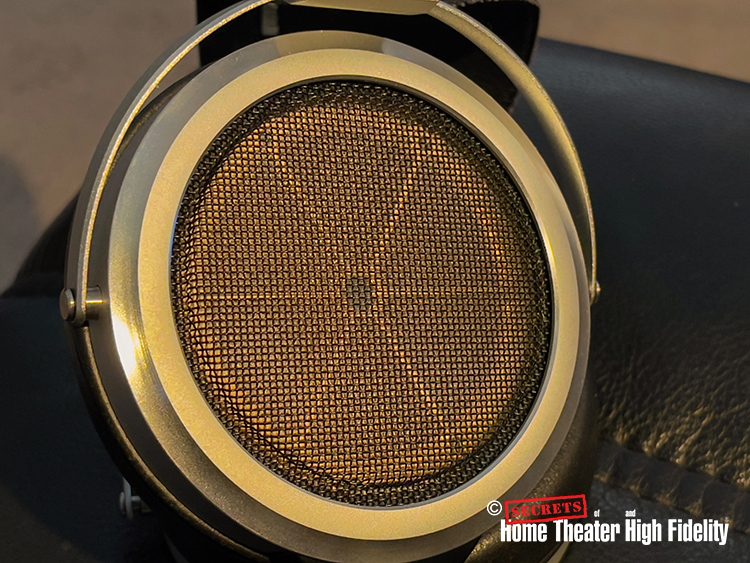
You can see and feel the quality as you handle the headphones.
The SRM-D50 is another exquisite piece. It’s made of the best materials. Even flipping a switch or changing an input gives you a feeling that this is aircraft or military grade hardware. The illuminated VU Meter adds to the high-end appearance, along with high quality hardware on the input and output panel.
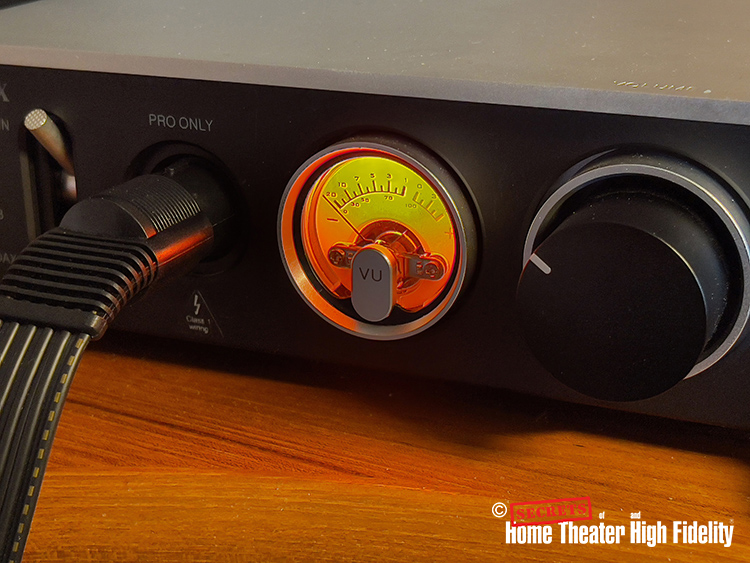
The SRM-D50 plugs into a normal AC wall outlet. You connect your source via analog, or digital inputs like optical or a USB input.
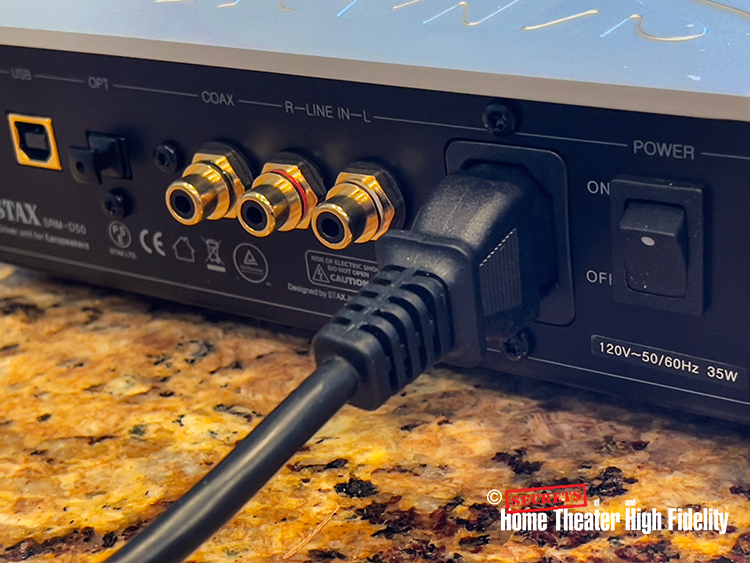
On the front panel is a source selection switch. A volume control, and the VU Meter.
I’ve heard other Stax headphones over the years and have always been impressed. Last year I had long sessions with the Stax SR-L700 Mk II headphones, which were superb.
I called them “a reference design which is one of the most impressive devices for listening to music that I’ve ever heard.”
So how does Stax top that device? There are some physical differences. The older Stax has a squarish design, harking back to Stax designs from the 70s, while the SR-009S is rounded. Both designs enclose, but do not seal the ear, and the materials of the newer headphones is of very high-quality metals while the SR-L700 Mk II headphones are mostly high-quality plastic. Both headphones are light in weight.
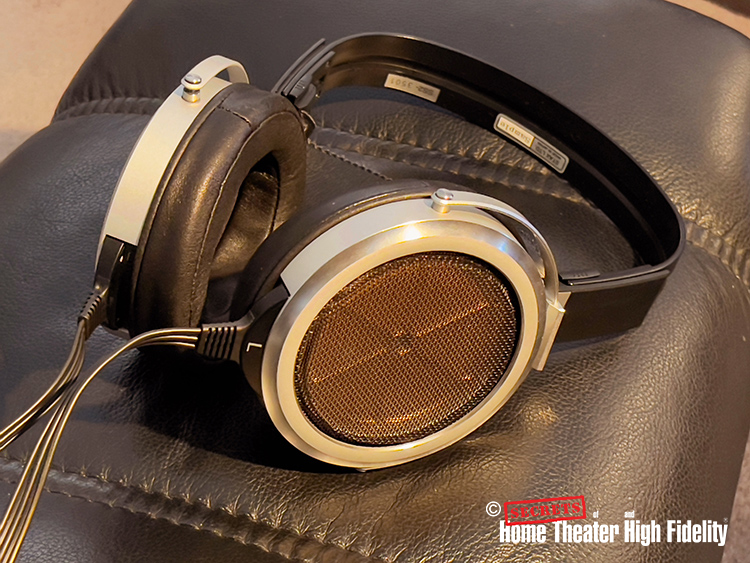
Sound-wise, both were excellent, and had the distinctive Stax house sound, which is neutral. Like most electrostatics, the high frequencies are extended, but not unnaturally so. The bass response of the SR-009S seems to go a bit lower than the earlier Stax I reviewed, but there’s more to the bass than that. On the Stax under review, you could hear a ‘thwack’ when a bass drum was struck, and then you would hear the rippling of the air in the room coming from all directions. It was more subtle on the other Stax headphone I reviewed, and even more subtle on some of the other high-quality headphones I have in house. In the final analysis, as it often is in the high end, small improvements can cost a lot of money, and the high end is all about subtle.
I listened to the Stax SR-009S three ways. First, though a FiiO M15 portable player. It’s loaded with all kinds of digital files, and FLACs ripped from CDs. Then I used the optical input to listen to files played by a Bluesound player/streamer, which can offer digital files in high resolution. I also listened to some CD quality files ripped as FLAC files played back from the Bluesound unit. Finally, I played music from the Tidal service.
I found that the better the source material, the better the Stax SR-009S headphones and amp/DAC sounded. There’s no surprise there. These headphones are extremely revealing. With no effort at times, I could hear music stands being moved as pages were turned, or even foot taps from the musicians.
Here’s some of the music I found intriguing on the Stax Earspeakers.
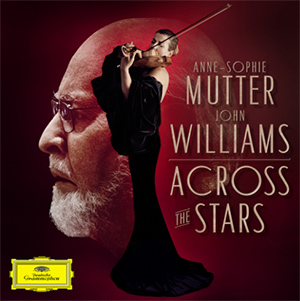
John Williams “John Williams: Across the Stars”
This standout 96kHz 24-bit recording just sounded wonderful. It’s a collection of some of Williams best music for the cinema with Anne-Sophie Mutter playing the violin. The first track, Rey’s Theme from Star Wars is just stunning. The violin is revealed as only an electrostatic headphone can, and there is deep but natural bass in this track as well. Listening to this will make you smile.

Elmer Bernstein “The Utah Symphony plays the music of Miklos Rozsa”
Elmer Bernstein: The Utah Symphony plays the music of Miklos Rozsa, in particular the New England Concerto for Two Pianos and Orchestra. This FLAC CD rip also point out the phenomenal ability of the Stax headphones to create a virtual listening place. Listening to this track on high-quality speakers is a good experience. On headphones, you can tell the two pianos are a few feet apart, and their sound, when playing together, is very distinct as to their locations.
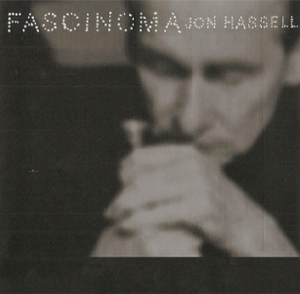
Jon Hassell “Fascinoma”
Fascinoma: Jon Hassell, Ry Cooder. Very interesting; hard to characterize. Mood music, Avant-garde? The musicians create a compelling audio environment that spreads out in front of the listener. If you liked these tracks on speakers, headphones will surely appeal to you. The Stax SR-009S headphones will really excite you beyond measure.

Simon and Garfunkel “Sounds of Silence”
You’ve heard these tracks hundreds of times. On the Stax headphones, they are like brand new. Recorded when Columbia Records was at their engineering peak, the voices sound real, the instruments are spread across the soundfield, and Simon and Garfunkel have never rounded better.

Bernard Hermann “The Classic Film Scores”
This is a newer recording of some great Hermann music from his films. Listen to ‘Talking Drums’ from the film White Witch Doctor and it will tell you if you are listening to good speakers or headphones. The Stax SR-009S could not sound more realistic playing this challenging music. This music is also a test of separation, which the Stax have conquered.
I was fortunate enough to have a listen to the Stax SR-009S/SRM-D50 combo after Mel had finished his evaluation. After sharing his thoughts with me, I think that Mel pretty much hit it on the mark with his assessments. From my own perspective, having recently reviewed the Stax SR-007A earspeakers and essentially gushing over them, I was interested to see if I could notice a difference between the two. They were close, really close. Where the SR-009S edged out the 007A was in ultimate transparency. I thought the SR-007A were the ultimate in clarity but the 009S somehow eke out just a little bit more. Both sounded incredibly neutral in character, and both have, at least to me, about the same depth of bass reach. But the SR-009A just sounded as clear as light. I don’t know that I can characterize it any better than that. One area that I preferred the SR-007A over the 009S (besides the price) was in comfort. The 007A have earcups that rotate allowing the cord connections to be conveniently positioned for ease-of-use. It’s a little detail, but one that I appreciated and missed having this time around.
Secrets Sponsor
The SRM-D50 is a classy looking little DAC/amp that does a great job powering SR-009S. It looks and feels just as well put together as the larger Stax amps that I got to use in my previous review. And the while the ESS ES9018 DAC it uses may be an older generation chip, it had no trouble decoding just about any music bit depth that I threw at it, save for DSD256. The VU meter is probably pointless but is just the right retro touch to complete the look of this amp. I loved watching bounce around like it was from some mad science experiment! The amp’s top casework got warm to the touch after about half an hour of use so I would definitely recommend adequate airspace be made available around it. The SRM-D50 had more than enough drive to make the SR-009S earspeakers sing, I never got the volume knob farther than the 12 o’clock position as that was as loud as I could bear. If I could wish for anything, I would have liked a set of balanced inputs to be included on the back panel. Otherwise, I think the SRM-D50 is just a peach of an amp and is just the right size for desktop environment.
The STAX SR-009S EARSPEAKERS and SRM-D50 AMPLIFIER provide some of the best quality headphone sound that one is likely to experience.
- The headphones and reviewed amp/DAC are a world class pair of components.
- Build quality is excellent. The amp/DAC look like something you’d find in a serious recording studio, and I’m sure you’ll find them there.
- You’ll hear everything you’re supposed to hear on high quality recordings, and they have enough resolving power to let you hear things you aren’t supposed to hear, like movement in the session.
- The Stax SR-009S is packaged like the high-quality component it is. Wonderful and robust boxes, with striking designs.
- I’m at a loss here. Perhaps Stax will let this sound and build quality trickle down to a less expensive headphone/amp/DAC. But I think that’s already happening with their less expensive headphones on offer.
- One small caution. If you are listening and others are in the room, they are likely to faintly hear your headphones. It’s not a matter of bad design. Many headphones don’t create a seal keeping outside sounds out and letting some of the sound of the headphones escape. Just letting potential buyers know.
I can’t say these are the best headphones ever, as I haven’t heard all the well-engineered headphone out there. I can say, they are the best I’ve heard in years of reviewing headphones and listening to them at home and at various audio shows. These headphones are a collection of small, subtle improvements that individually make an incremental contribution to the sound, but taken together, they make a substantial leap. The construction and materials chosen; the very high-quality amp/DAC that takes nothing away from the music in terms of noise or distortion, while the sound from high-resolution files emerges from stark, electronic silence. The frequency response of the amp/DAC, combined with the wide response of the SR-009S transducers and dynamic range are easily noticeable.
Is a headphone ‘system’ (for that is what this pairing becomes) worth $5800.00? It’s roughly the cost of a pair of many well-regarded high-end speakers, so for audiophiles of that class, I think they are. For most of us, I think a serious look at the lower end of the Stax line are worth thinking about because they share similar DNA and a rich heritage of sound engineering.
Again, many thanks to Audio 46 for providing the review samples.


